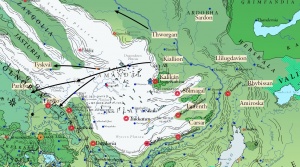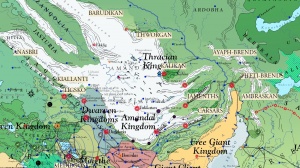Gwenyan Tribes of the High Shadevan Valley

These tribes are the ancestors of the later Jaggudornish Sky Tribes. This time is roughly 600 to 500 before Salmakhamer. These tribes hold their origins around 1,100 AS when the Thwarrish Gwenyan tribes migrated into the High Shadevan Valley. Their legends recount that they acknowledged a sacral king during the period of 1,100 to 600 AS. In the sixth century AS (600 to 500), they adapted skycraft. This increased resources available, namely gontha, invited competition for herding resources and pasturage, and saw the collapse of the sacral kingship. The Kiallion Tribe last claimed the kingship and fought with the Kalikán without resolution of the conflict. The Parkyons, Tyskvál, Tigskö tribes emerged from the Kiallion Tribe and emigrated with primitive skycraft across the Jaggudorns to the western slopes where they herded and expanded unmolested for about another three centuries. The Thworgan tribe migrated north, coming into conflict with the Uglyami (goblins) and the Kalikán became the hegemonic tribe of Thrace, holding the sacred shrine of Tuvar (Thwar). The Amiroska became the pre-eminent among the eastern tribes of the Sardons, the Llilugdavions, and the Rhybissans.
Gwenyan Tribes of the High Shadevan Valley (600 to 501 Before Salmakhamer)
After about a thousand years, the Thwarrish Sky Tribes had developed into powerful human tribes, dependent upon skycraft for warfare and herding. They had grown rich in numbers and material wealth and were well-known to merchants and rulers of the Pallathantic Region, including the Midretassene Empire and later the Yophenthean Empire. The Solmigál Sky people had emigrated in the intervening time to the Memnosian Sea. At this time, the Kalikán, the Tigskö, and the Ambraskan were pre-eminent. The Kiallanti were of old Colnorian stock and related to the Parkyons, the ancient Kiallions, and the Tigskö.
Gwenyan Tribes of the High Shadevan Valley (300 to 400 After Salmakhamer)
Gwenyan Tribes of the High Shadevan Valley (ca 986 AI)
See Also
| This article is a stub. It requires further development by the creator. |
